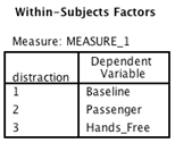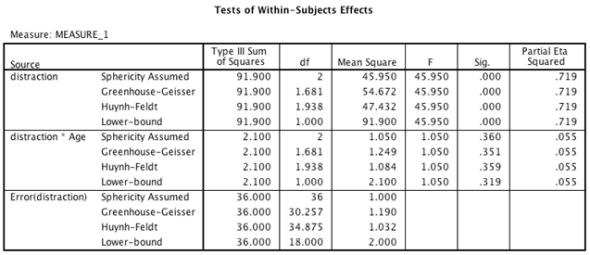Multiple Choice
An experiment was done to compare the effect of having a conversation via a hands-free mobile phone, having a conversation with an in-car passenger, and no distraction (baseline) on driving accuracy. Twenty participants from two different age groups (18-25 years and 26-40 years) took part. All participants in both age groups took part in all three conditions of the experiment (in counterbalanced order) , and their driving accuracy was measured by a layperson who remained unaware of the experimental hypothesis.
- Which of the following sentences regarding the results of the simple contrasts of the distraction variable is correct?


A) The second contrast tells us that driving was significantly different when having a conversation via a hands-free mobile phone compared to when having no conversation, F(1, 18) = 105.81, p < .001.However, we cannot tell the direction of this effect without further analyses.
B) The second contrast tells us that driving was significantly more accurate when having a conversation via a hands-free mobile phone compared to when having no conversation, F(1, 18) = 105.81, p < .001.
C) The second contrast tells us that driving was not significantly different when having a conversation with an in-car passenger compared to when having no conversation, F(1, 18) = 2.09, p = .855.
D) The second contrast tells us that driving was significantly less accurate when having a conversation via a hands-free mobile phone compared to when having no conversation, F(1, 18) = 105.81, p < .001.
Correct Answer:

Verified
Correct Answer:
Verified
Q3: An experiment was done to compare the
Q4: Which of the following assumptions are relevant
Q5: Field and Lawson (2003) reported the
Q6: An experiment was conducted to see how
Q7: Which of the following sentences is correct?<br>A)The
Q9: Field and Lawson (2003) reported the
Q10: An experiment was done to compare the
Q11: An experiment was done to compare the
Q12: An experiment was conducted to see how
Q13: An experiment was done to compare